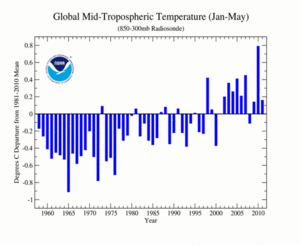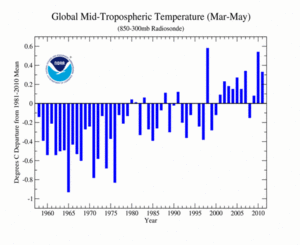Contents of this Section:
Note: Beginning in December 2010, all data are reported here with respect to the 1981–2010 base period. Prior to December 2010, radiosonde data were reported with respect to the 1961–1990 base period and satellite data were reported with respect to the 1979–1998 base period. Remote Sensing Systems continues to provide data to NCDC with respect to the 1979–1998 base period; however, NCDC readjusts the data to the 1981–2010 base period so that the satellite measurements are comparable. This change provides a more consistent comparison between the various datasets.
Note: Effective with the January 2011 report, Remote Sensing Systems (RSS) transitioned to a new version (3.3) of the RSS MSU/AMSU atmospheric temperature datasets. Information about the differences between version 3.2 and 3.3 is availablehere.
Upper Air Highlights
University of Alabama Huntsville satellite analyses report that the lower troposphere May 2011 temperature was 0.14°C (0.25°F) above the 1981–2010 average, the eighth warmest since satellite records began in 1979. The seasonal March–May period was the 13th warmest on record while the year-to-date period was 14thwarmest.
Remote Sensing Systems satellite analyses report a lower troposphere May temperature anomaly of 0.04°C (0.07°F) above the 1981–2010 base period, the 12th warmest on record. Both the seasonal March–May and year-to-date periods ranked 18th warmest (16th coolest).
University of Alabama Huntsville satellite analyses report a May 2011 mid-troposphere temperature anomaly of 0.01°C (0.02°F) above average, the 14th warmest such period on record. When these analyses are adjusted to remove stratospheric influence, the anomaly increases to 0.10°C (0.18°F) above average, the 10th warmest on record.
Remote Sensing Systems satellite analyses report a May 2011 mid-troposphere temperature anomaly of 0.01°C (0.03°F) below average, the 15th warmest such period on record. When these analyses are adjusted to remove stratospheric influence, the anomaly increases to 0.07°C (0.13°F) above average, the 13th warmest on record.
For the lower stratosphere, both University of Alabama Huntsville and Remote Sensing Systems satellite data indicate that May 2011 was the coolest May in the 33-year period of record. Both report that the March–May period was third coolest on record.
Troposphere
Temperatures above the Earth's surface are measured within the lower troposphere, middle troposphere, and stratosphere using in-situ balloon-borne instruments (radiosondes) and polar-orbiting satellites (NOAA's TIROS-N). The radiosonde and satellite records have been adjusted to remove time-dependent biases (artificialities caused by changes in radiosonde instruments and measurement practices as well as changes in satellite instruments and orbital features through time). Global averages from radiosonde data are available from 1958 to present, while satellite measurements date back to 1979.
Lower Troposphere
Current Month | Seasonal | Year-to-date
These temperatures are for the lowest 8 km (5 miles) of the atmosphere. Information on the University of Alabama in Huntsville (UAH) and Remote Sensing Systems (RSS) sources of troposphere data is available.
| May | Anomaly | Rank (out of 33 years) |
Warmest (or Next Warmest) Year on Record | Trend |
|---|---|---|---|---|
| *UAH low-trop | +0.14°C/+0.25°F | 8th warmest | 1998 (+0.57°C/+1.03°F) | +0.11°C/decade |
| RSS low-trop | +0.04°C/+0.07°F | 12th warmest | 1998 (+0.58°C/+1.05°F) | +0.12°C/decade |
*Version 5.3
| March–May | Anomaly | Rank (out of 33 years) |
Warmest (or Next Warmest) Year on Record | Trend |
|---|---|---|---|---|
| *UAH low-trop | +0.05°C/+0.10°F | 13th warmest | 1998 (+0.55°C/+1.00°F) | +0.12°C/decade |
| RSS low-trop | -0.04°C/-0.07°F | 18th warmest | 1998 (+0.60°C/+1.08°F) | +0.14°C/decade |
*Version 5.3
| January– May |
Anomaly | Rank (out of 33 years) |
Warmest Year on Record | Trend |
|---|---|---|---|---|
| *UAH low-trop | +0.03°C/+0.05°F | 14th warmest | 1998 (+0.56°C/+1.01°F) | +0.13°C/decade |
| RSS low-trop | -0.04°C/-0.07°F | 18th warmest | 1998 (+0.57°C/+1.03°F) | +0.14°C/decade |
*Version 5.3
Mid-troposphere
Current Month | Seasonal | Year-to-date
These temperatures are for the atmospheric layer centered in the mid-troposphere (approximately 3–10 km [2–6 miles] above the Earth's surface), which also includes a portion of the lower stratosphere. (The Microwave Sounding Unit [MSU] channel used to measure mid-tropospheric temperatures receives about 25 percent of its signal above 10 km [6 miles].) Because the stratosphere has cooled due to increasing greenhouse gases in the troposphere and losses of ozone in the stratosphere, the stratospheric contribution to the tropospheric average, as measured from satellites, may create an artificial component of cooling to the mid-troposphere temperatures. The University of Washington (UW) versions of the UAH and RSS analyses attempt to remove the stratospheric influence from the mid-troposphere measurements, and as a result the UW versions tend to have a larger warming trend than either the UAH or RSS versions. For additional information, please see NCDC's Microwave Sounding Unit page.
The radiosonde data used in this global analysis were developed using the Lanzante, Klein, Seidel (2003) ("LKS") bias-adjusted dataset and the First Difference Method (Free et al. 2004) (RATPAC). Additional details are available. Satellite data have been adjusted by the Global Hydrology and Climate Center at the University of Alabama in Huntsville (UAH). An independent analysis is also performed by Remote Sensing Systems (RSS) and a third analysis has been performed by Dr. Qiang Fu of the University of Washington (UW) (Fu et al. 2004)** to remove the influence of the stratosphere on the mid-troposphere value. Global averages from radiosonde data are available from 1958 to present, while satellite measurements began in 1979.
Radiosonde measurements indicate that, for the January–May year-to-date period, temperatures in the mid-troposphere were 0.16°C (0.29°F) above average, resulting in the 9th warmest January–May period (out of 54 years). Satellite analyses of the January–May year-to-date period for the middle troposphere ranked from 18th to 24th warmest, depending on the data source, in the 33-year satellite record.
Radiosonde measurements indicate that mid-tropospheric temperatures were 0.33°C (0.59°F) above average during the Northern Hemisphere spring season, giving March–May a rank of 4th warmest on record. The table below shows that satellite measurements for the season were 19th to 25th warmest on record, depending on the data source.
| May | Anomaly | Rank (out of 33 years) |
Warmest Year on Record | Trend |
|---|---|---|---|---|
| *UAH mid-trop | +0.01°C/+0.02°F | 14th warmest | 1998 (+0.58°C/+1.04°F) | +0.03°C/decade |
| RSS mid-trop | -0.01°C/-0.03°F | 15th warmest | 1998 (+0.60°C/+1.08°F) | +0.06°C/decade |
| UW-*UAH mid-trop | +0.10°C/+0.18°F | 10th warmest | 1998 (+0.67°C/+1.21°F) | +0.09°C/decade |
| UW-RSS mid-trop | +0.07°C/+0.13°F | 13th warmest | 1998 (+0.68°C/+1.12°F) | +0.10°C/decade |
*Version 5.3
| March–May | Anomaly | Rank (out of 33 years) |
Warmest (or Next Warmest) Year on Record |
Trend |
|---|---|---|---|---|
| *UAH mid-trop | -0.11°C/-0.19°F | 25th warmest | 1998 (+0.58°C/+1.04°F) | +0.03°C/decade |
| RSS mid-trop | -0.10°C/-0.18°F | 23rd warmest | 1998 (+0.58°C/+1.05°F) | +0.07°C/decade |
| UW-*UAH mid-trop | -0.04°C/-0.08°F | 19th warmest | 1998 (+0.67°C/+1.20°F) | +0.08°C/decade |
| UW-RSS mid-trop | -0.04°C/-0.07°F | 19th warmest | 1998 (+0.65°C/+1.18°F) | +0.12°C/decade |
| RATPAC | +0.33°C/+0.59°F | 4thwarmest | 1998 (+0.58°C/+1.04°F) | +0.15°C/decade |
*Version 5.3
| January– May |
Anomaly | Rank (out of 33 years) |
Warmest (or Next Warmest) Year on Record |
Trend |
|---|---|---|---|---|
| *UAH mid-trop | -0.12°C/-0.22°F | 24th warmest | 1998 (+0.57°C/+1.03°F) | +0.03°C/decade |
| RSS mid-trop | -0.10°C/-0.18°F | 21st warmest | 1998 (+0.56°C/+1.01°F) | +0.08°C/decade |
| UW-*UAH mid-trop | -0.06°C/-0.11°F | 20th warmest | 1998 (+0.66°C/+1.19°F) | +0.08°C/decade |
| UW-RSS mid-trop | -0.04°C/-0.07°F | 18th warmest | 1998 (+0.64°C/+1.15°F) | +0.13°C/decade |
| RATPAC | +0.16°C/+1.29°F | 9thwarmest | 2010 (+0.79°C/+1.42°F) | +0.16°C/decade |
*Version 5.3
Note: RATPAC's rank is based on records that began in 1958 (54 years).
Stratosphere
The table below summarizes stratospheric conditions for May 2011. On average, the stratosphere is located approximately 16–23 km (10–14 miles) above the Earth's surface. Over the last decade, stratospheric temperatures have been below average in part due to the depletion of ozone. The large positive anomaly in 1982 was caused by the volcanic eruption of El Chichon in Mexico, and the sharp jump in temperature in 1991 was a result of the eruption of Mt. Pinatubo in the Philippines. In both cases the temperatures returned to pre-eruption levels within two years.
| May | Anomaly | Rank (out of 33 years) |
Coolest (or Next Coolest) Year on Record |
|---|---|---|---|
| *UAH stratosphere | -0.64°C (-1.15°F) | coolest | 2008 (-0.49°C/-0.88°F) |
| RSS stratosphere | -0.60°C (-1.08°F) | coolest | 1996 (-0.39°C/-0.70°F) |
*Version 5.3
| March–May | Anomaly | Rank (out of 33 years) |
Coolest (or Next Coolest) Year on Record |
|---|---|---|---|
| *UAH stratosphere | -0.44°C (-0.80°F) | 3rd coolest | 1999 (-0.48°C/-0.87°F) |
| *RSS stratosphere | -0.40°C (-0.72°F) | 3rd coolest | 1999 (-0.42°C/-0.75°F) |
*Version 5.3
References
Christy, John R., R.W. Spencer, and W.D. Braswell, 2000: MSU tropospheric Temperatures: Dataset Construction and Radiosonde Comparisons. J. of Atmos. and Oceanic Technology, 17, 1153-1170.
Free, M., D.J. Seidel, J.K. Angell, J. Lanzante, I. Durre and T.C. Peterson (2005) Radiosonde Atmospheric Temperature Products for Assessing Climate (RATPAC): A new dataset of large-area anomaly time series, J. Geophys. Res., 10.1029/2005JD006169.
Free, M., J.K. Angell, I. Durre, J. Lanzante, T.C. Peterson and D.J. Seidel(2004), Using first differences to reduce inhomogeneity in radiosonde temperature datasets, J. Climate, 21, 4171-4179.
Fu, Q., C.M. Johanson, S.G. Warren, and D.J. Seidel, 2004: Contribution of stratospheric cooling to satellite-inferred tropospheric temperature trends. Nature, 429, 55-58.
Lanzante, J.R., S.A. Klein, and D.J. Seidel (2003a), Temporal homogenization of monthly radiosonde temperature data. Part I: Methodology, J. Climate, 16, 224-240.
Lanzante, J.R., S.A. Klein, and D.J. Seidel (2003b), Temporal homogenization of monthly radiosonde temperature data. Part II: trends, sensitivities, and MSU comparison, J. Climate, 16, 241 262.
Mears, Carl A., M.C. Schabel, F.J. Wentz, 2003: A Reanalysis of the MSU Channel 2 tropospheric Temperature Record. J. Clim, 16, 3650-3664.
 NOAA's National Centers for Environmental Information
NOAA's National Centers for Environmental Information

